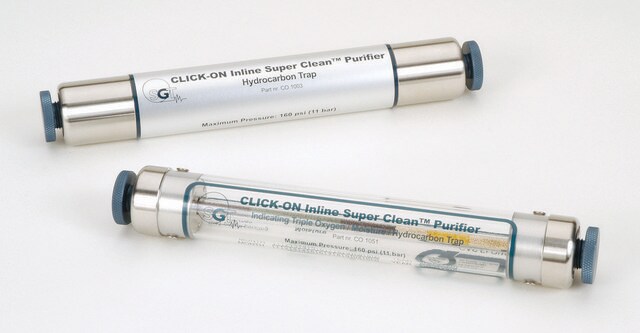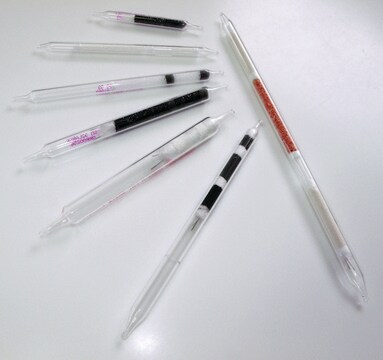10184
Carbosieve Carbon Adsorbent
matrix Carbosieve S-III, 60-80 mesh, bottle of 10 g
About This Item
Empfohlene Produkte
Produktbezeichnung
Carbosieve-Adsorbens, matrix Carbosieve S-III, 60-80 mesh, bottle of 10 g
Produktlinie
Carbosieve
Qualitätsniveau
Form
powder, crystals or granules
Verpackung
bottle of 10 g
Parameter
400 °C max. temp.
Methode(n)
LPLC: suitable
gas chromatography (GC): suitable
solid phase extraction (SPE): suitable
Oberflächenbereich
~975 m2/g
Matrix
Carbosieve S-III
Aktive Matrixgruppe
carbon
Partikelgröße
60-80 mesh
Porengröße
~0.04 cm3/g mesoporosity
~0.35 cm3/g microporosity
~0 cm3/g macroporosity
~4-11 pore diameter
Dichte
~0.66 g/mL (free fall density)
Trenntechnik
reversed phase
Verwandte Kategorien
Allgemeine Beschreibung
- Kugelförmig (bessere Festbettleistung als bei granulären Teilchen)
- Hart und nicht bröckelnd (leicht zu füllen, kein Bruch)
- Hochporös (große Oberflächen)
- Wird für Moleküle mit einer von C2–C5 n-Alkanen abhängigen Analytgröße verwendet
- Hydrophob (können in Umgebungen mit hoher Luftfeuchtigkeit eingesetzt werden)
CMS-Adsorbentien bieten generell eine relative höhere Adsorptionskraft als perlförmige Adsorbentien aus graphitisierter Polymerkohle (SGPC) und graphitisiertem Kohlenschwarz (GCB). Unsere Carbosieve-Produkte sind eine Art von CMS-Adsorbentien.
- Keine konischen Poren
- Sehr hohe Adsorptionskraft, da nur Mikroporen vorhanden sind
- Erstklassige Leistung bei vielen kleinen, flüchtigen Analyten, die von den meisten anderen Adsorbentien nur schwer zurückgehalten werden
Weitere Informationen über unsere speziellen Kohlenstoffadsorbentien finden Sie auf ww.sigma-aldrich.com/carbon
Rechtliche Hinweise
Lagerklassenschlüssel
13 - Non Combustible Solids
WGK
WGK 3
Flammpunkt (°F)
Not applicable
Flammpunkt (°C)
Not applicable
Persönliche Schutzausrüstung
Eyeshields, Gloves, type P3 (EN 143) respirator cartridges
Hier finden Sie alle aktuellen Versionen:
Analysenzertifikate (COA)
Die passende Version wird nicht angezeigt?
Wenn Sie eine bestimmte Version benötigen, können Sie anhand der Lot- oder Chargennummer nach einem spezifischen Zertifikat suchen.
Besitzen Sie dieses Produkt bereits?
In der Dokumentenbibliothek finden Sie die Dokumentation zu den Produkten, die Sie kürzlich erworben haben.
Kunden haben sich ebenfalls angesehen
Artikel
Carbon Molecular sieves (CMS) are a versatile range of adsorbents that can be tailored for specific applications. Supelco® scientists have been synthesizing synthetic CMS carbons for several decades, starting from tailoring of the starting polymers/copolymers, to modifying the final properties of the subsequent CMS carbon.
Global Trade Item Number
| SKU | GTIN |
|---|---|
| 270814-5G | 4061832618814 |
| 270814-1G | |
| 10184 | 4061833656068 |
Unser Team von Wissenschaftlern verfügt über Erfahrung in allen Forschungsbereichen einschließlich Life Science, Materialwissenschaften, chemischer Synthese, Chromatographie, Analytik und vielen mehr..
Setzen Sie sich mit dem technischen Dienst in Verbindung.










